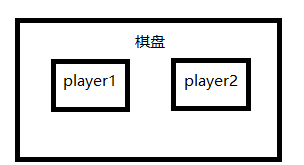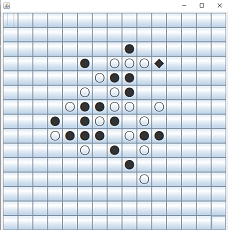框架的搭建
首先,我们计划是做一个五子棋AI,也就是说让玩家和这个AI对下。整个游戏的框架是这样的:
其中,棋盘是一个Object,存放当前的棋局情况,通知每个Player“轮到你下棋了”、“对方下了什么棋”、“游戏结束,XXX获胜”等消息,并且从每个Player那里获取他下了什么棋。两个Player分别是人类玩家和AI。Player的基类应该是一个interface,里面只有三个方法。人类玩家和AI是它的子类,分别实现这三个方法。
public interface Player {
Point play();
void display(Point p);
void notifyWinner(int color);}- 1
- 2
- 3
- 4
public final class Point {
public final int x;
public final int y;
public Point(int x, int y) {
this.x = x;
this.y = y;
}
@Override
public String toString() {return "(" + x + "," + y + ")";}}- 1
- 2
- 3
- 4
- 5
- 6
- 7
- 8
- 9
解释一下:
- play 方法,告知“轮到你下棋了”,并且返回一个Point,也就是下一步下的棋。对于人类玩家,则就是阻塞,等待玩家在界面上选取一个点,并且将这个点的坐标返回。对于AI,则是直接开始用我们的AI算法进行计算,并返回计算结果。
- void display(Point p) 方法,告知“对方下了什么棋”。对于人类玩家,则就是将对方下了的棋在界面上显示出来。对于AI,则是将对方下了的棋记在AI的缓存中,以便后续的计算。
- void notifyWinner(int color) 方法,告知“游戏结束,XXX玩家赢了”。对于人类玩家,则就是在界面上展示谁赢了的文字及特效,并且从此之后再点击棋盘就不再有反应了。对于AI,则是通知AI不要再计算了。
当然了,如果打算连续下多盘棋,可能还需要一个reset方法,通知人类玩家和AI清空当前棋盘。当然了,这个和我们的算法关系不大就不列出来了。
然后,我们的interface Player需要两个实现类,分别叫做HumanPlayer和RobotPlayer,这个RobotPlayer的play方法将是五子棋AI算法的核心内容,后面会花费大量篇幅进行讲解。
接下来就是我们的棋盘:
public abstract class Constant {
public static int MAX_LEN = 15;}- 1
- 2
public class ChessBoard {
private byte[][] board = new byte[Constant.MAX_LEN][Constant.MAX_LEN];
private Player[] players = new Player[2];
private int whoseTurn = 0;
private int count = 0;
private boolean isEnd = false;
private boolean checkForWin(Point p) {
/* 因为篇幅问题,此处省略十几行代码 */
/* 这个函数就是在下完每一步棋时调用,只需要判断以这步棋若形成五连珠即可判定获胜 */
return false;
}
public void play() {
if (isEnd) return;
Point p = players[whoseTurn].play(); //调用Player的play方法,获取下一步下的棋
if (board[p.y][p.x] != 0) //严谨,以防万一
throw new IllegalArgumentException(p.toString() + board[p.y][p.x]);
board[p.y][p.x] = (byte) (whoseTurn + 1);
System.out.println((whoseTurn == 0 ? "黑" : "白") + p.toString()); //打印日志
if (++count == Constant.MAX_LEN * Constant.MAX_LEN) //严谨,如果棋盘下满了游戏结束
isEnd = true;
if (checkForWin(p)) //如果下了这步棋后赢了,游戏结束
isEnd = true;
whoseTurn = 1 - whoseTurn; //切换当前下棋的人
players[whoseTurn].display(p); //调用Player的display方法,告知他对方下了哪步棋
if (isEnd) { //如果下完这一步棋后有一方赢了,则调用Player的notifyWinner方法通知
players[0].notifyWinner(2 - whoseTurn);
players[1].notifyWinner(2 - whoseTurn);
}
}
public static void main(String[] args) {
ChessBoard b = new ChessBoard();
b.players[0] = new HumanPlayer(1); //这里我从构造函数中传入了颜色,例如1表示执黑,2表示执白
b.players[1] = new RobotPlayer(2);
while (b.getWinner() == null) {
b.play();
}
}}- 1
- 2
- 3
- 4
- 5
- 6
- 7
- 8
- 9
- 10
- 11
- 12
- 13
- 14
- 15
- 16
- 17
- 18
- 19
- 20
- 21
- 22
- 23
- 24
- 25
- 26
- 27
- 28
- 29
- 30
- 31
- 32
- 33
- 34
- 35
- 36
- 37
- 38
- 39
- 40
棋盘的代码确实很简单易懂,也做了很多注释,就不多介绍了。
接下来,就只剩下HumanPlayer和RobotPlayer的实现了。
人类玩家
人类玩家无非就是实现三个方法:
- play 方法,阻塞等待玩家点击棋盘上的一个点并返回这个点
- display 方法,将AI下的棋展示在界面上
- notifyWinner 方法,显示一行字“你赢(输)了”
这段代码与本文无关,就不贴出来了,我把我做的这个丑陋的界面贴出来展示一下,哈哈。
(不要吐槽我的界面,这不是重点。)
RobotPlayer
AI才是重点内容,涉及了大量的算法和数学知识,博弈树、评估函数、极大极小值搜索、启发式搜索、α-β剪枝等等,将会占用大量的篇幅。从下篇博客开始,将对此逐一展开。

 随时随地看视频
随时随地看视频



